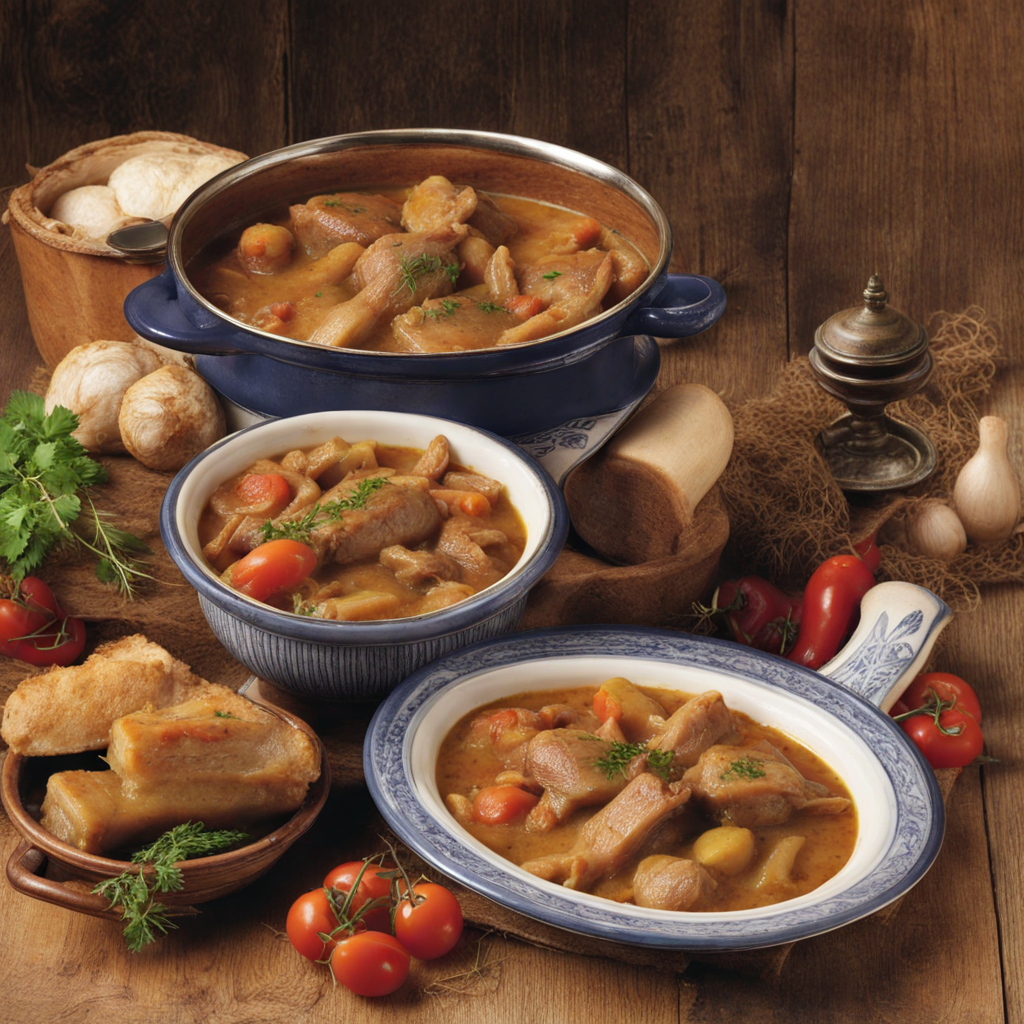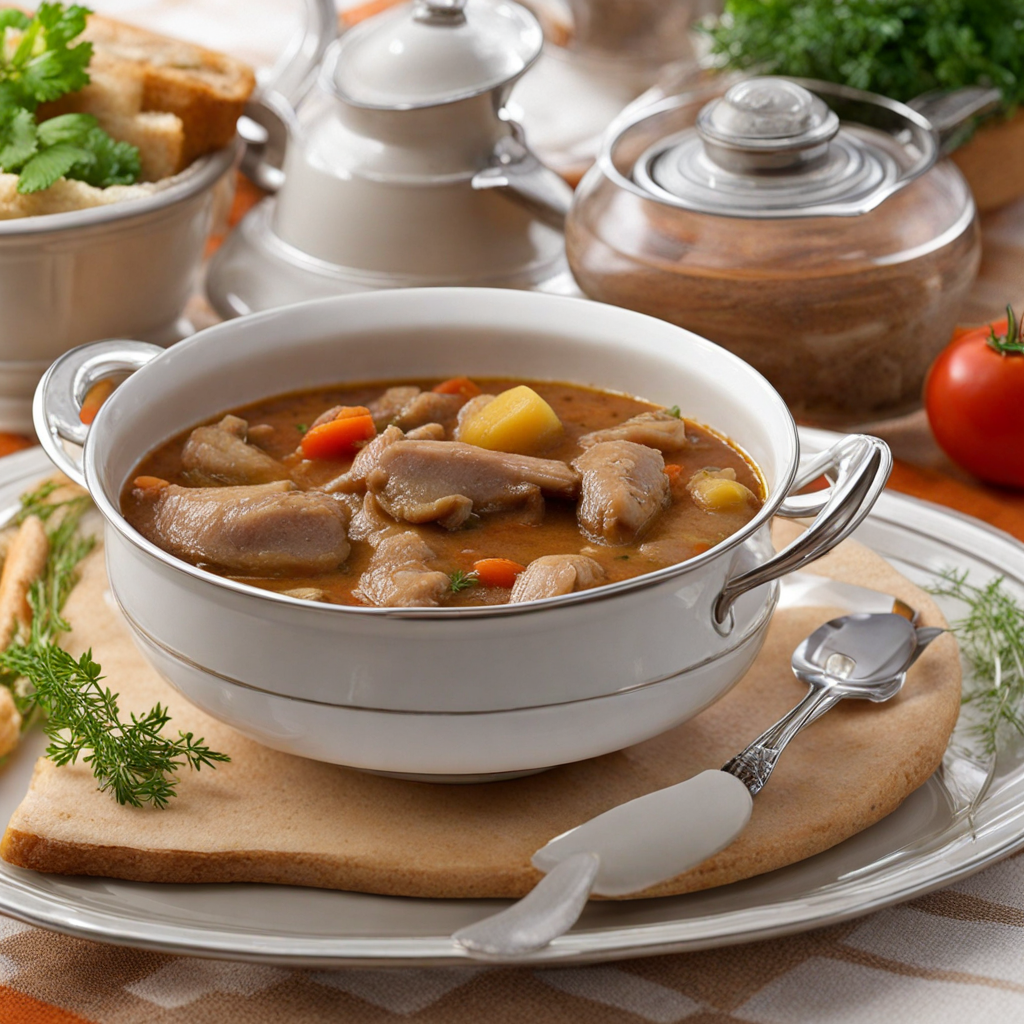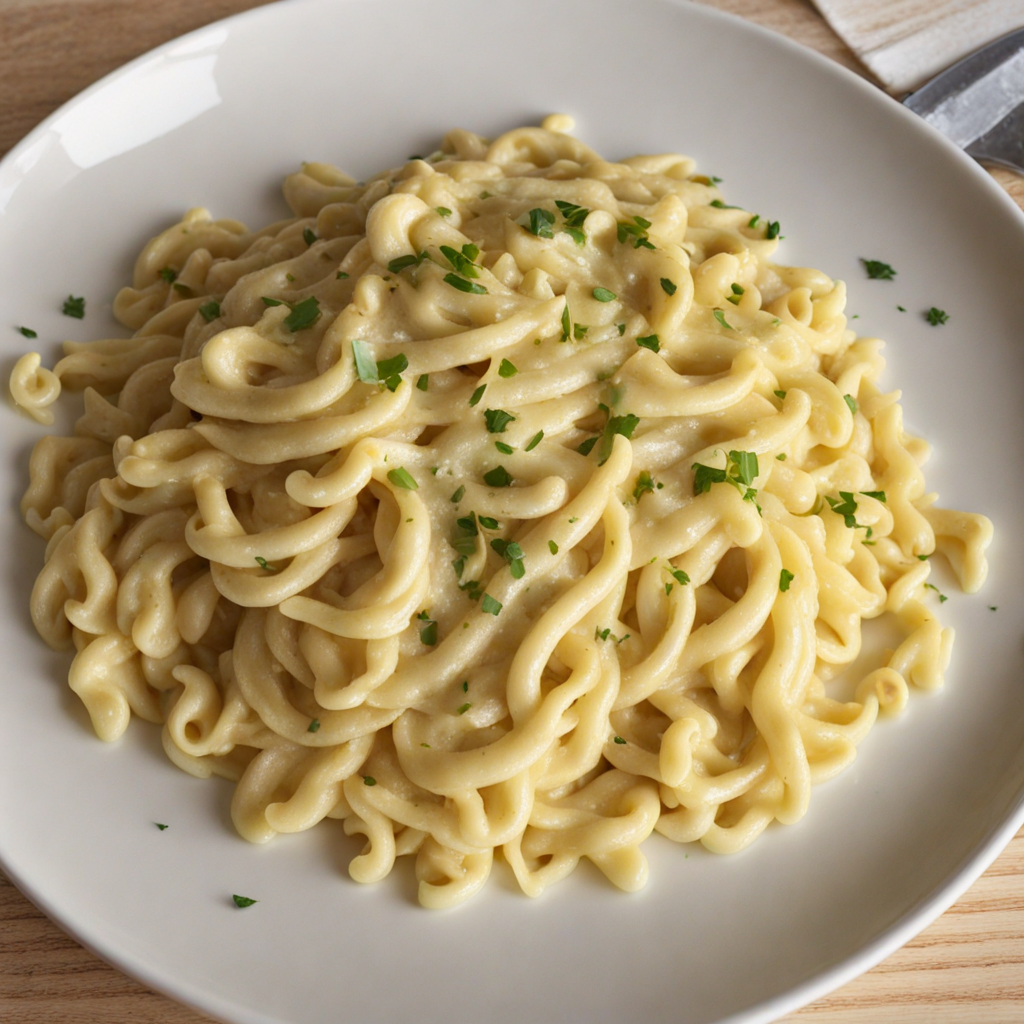Hasenpfeffer
Hasenpfeffer is a traditional German dish that showcases the rich flavors of rabbit, often prepared in a hearty stew. The rabbit meat is marinated in a mixture of red wine, vinegar, and an array of aromatic spices that typically include bay leaves, juniper berries, and peppercorns. This marinade not only tenderizes the meat but also infuses it with a depth of flavor that is both earthy and slightly tangy, setting the stage for a truly unique culinary experience. Once marinated, the rabbit is braised until it reaches the perfect level of tenderness, allowing the flavors to meld beautifully as it cooks. The dish is often served with a thick sauce made from the braising liquid, which is reduced to intensify the flavors. The sauce is typically enriched with additional ingredients such as onions, carrots, and sometimes even a splash of cream or a touch of flour to achieve a velvety consistency. Hasenpfeffer is traditionally accompanied by hearty sides like dumplings or spaetzle, which soak up the luscious sauce, making every bite a delightful combination of flavors and textures. The rustic charm of the dish reflects the agricultural roots of German cuisine, celebrating the use of local ingredients and time-honored cooking techniques. In terms of taste, Hasenpfeffer offers a remarkable balance of savory and slightly sweet notes, with the tender rabbit providing a lean but flavorful protein that is complemented by the richness of the sauce. The use of red wine and spices adds complexity, making each bite an exploration of both familiar and novel flavors. Whether enjoyed at a festive gathering or as a comforting family meal, Hasenpfeffer is a dish that invites food lovers to savor the warmth and heartiness of German culinary traditions, all while indulging in the unique taste of rabbit, a protein that is often underappreciated in modern cuisine.
How It Became This Dish
The History of Hasenpfeffer: A Culinary Journey Through Germany Hasenpfeffer, a traditional German dish, is a rich and hearty stew made primarily from hare or rabbit, often marinated in a blend of vinegar, wine, spices, and onions. Its name, derived from the German words "Hase" (hare) and "Pfeffer" (pepper), reflects the dish's robust flavors and its origins rooted in rustic German cuisine. This dish not only serves as a testament to Germany's culinary heritage but also embodies its cultural significance, reflecting historical practices, societal changes, and regional influences. #### Origins in Medieval Germany The origins of Hasenpfeffer can be traced back to medieval Germany, where the consumption of game meat was prevalent among the nobility and the peasantry alike. The practice of hunting hares and rabbits was not only a means of sustenance but also a social activity that fostered community and camaraderie among hunters. Game meat was often considered a delicacy, and in times of scarcity, it provided essential nutrition. The earliest recipes for Hasenpfeffer are believed to have emerged in the 14th century. They highlight the use of vinegar and wine for marination, ingredients that were essential for preserving meat before the advent of refrigeration. The marination process was crucial, as it tenderized the meat and infused it with flavor, allowing the dish to stand out in a time when food preservation was a significant concern. #### Cultural Significance Hasenpfeffer is deeply embedded in German culture, particularly in regions where hunting is a tradition. It is often associated with rural life and seasonal festivities. The dish is typically prepared during hunting season, which usually spans from autumn to winter, making it a popular choice for family gatherings and celebrations. In many German households, Hasenpfeffer is more than just a meal; it represents a communal experience. Families often come together to prepare the dish, sharing stories and laughter as they chop vegetables, marinate the meat, and simmer the stew. This sense of togetherness is characteristic of many German culinary traditions, where food serves as a catalyst for social interaction. Moreover, Hasenpfeffer is often served during festive occasions such as Oktoberfest and Christmas, reflecting its status as a dish of celebration and abundance. It symbolizes the harvest and the bounty of nature, embodying the spirit of gratitude that characterizes many German traditions. #### Regional Variations As with many traditional dishes, Hasenpfeffer has evolved over time and across regions. Depending on local customs and the availability of ingredients, various adaptations of the stew have emerged. In some areas, such as Bavaria and the Rhineland, the dish may include additional ingredients like mushrooms, carrots, or even prunes to enhance the flavor profile. The use of different spices, such as juniper berries or bay leaves, also varies by region, reflecting the unique agricultural practices and local palates. In some German-speaking regions of Switzerland and Austria, Hasenpfeffer has maintained its popularity, often served in a similar style but with slight variations that reflect local culinary preferences. For instance, in Switzerland, the dish may be accompanied by spätzle (a type of egg noodle) or rösti (a Swiss potato dish), showcasing the influence of neighboring cuisines. #### Culinary Revival and Modern Interpretations In the 20th century, Hasenpfeffer experienced a decline in popularity, particularly in urban centers where lifestyles became more fast-paced and convenience foods dominated. However, in recent years, there has been a resurgence of interest in traditional German cuisine, driven by a broader movement towards local and sustainable food sourcing. Chefs and home cooks alike have begun to rediscover Hasenpfeffer, embracing its rich flavors and historical significance. Modern interpretations of Hasenpfeffer often include a variety of cooking techniques and presentation styles. While the traditional stew remains beloved, contemporary chefs may incorporate innovative ingredients or cooking methods, such as sous-vide or slow cooking, to enhance the dish's depth of flavor and tenderness. Additionally, the use of organic and ethically sourced hare or rabbit has become more common, reflecting a growing awareness of sustainability in food production. Moreover, Hasenpfeffer has found its way onto menus in gourmet restaurants, where chefs celebrate its rustic roots while adding a modern twist. Accompaniments have also evolved, with creative side dishes such as quinoa salads or roasted vegetables providing a lighter contrast to the rich stew. #### Conclusion: A Dish of Heritage and Community Hasenpfeffer is more than just a dish; it is a reflection of Germany’s rich culinary history and cultural identity. Its origins in medieval hunting practices, its significance in fostering community bonds, and its evolution through regional variations all contribute to its enduring appeal. As contemporary cooks and chefs continue to reinterpret this classic dish, Hasenpfeffer remains a testament to the importance of tradition, seasonal ingredients, and the joy of sharing a meal with loved ones. In a world that increasingly values local and sustainable food practices, Hasenpfeffer serves as a reminder of the past while embracing the future. Whether enjoyed in a rustic farmhouse or a modern restaurant, this hearty stew continues to warm hearts and bring people together, making it a cherished part of the culinary landscape in Germany and beyond.
You may like
Discover local flavors from Germany







